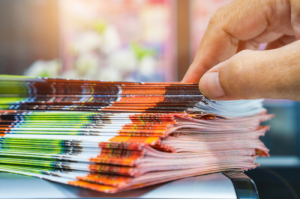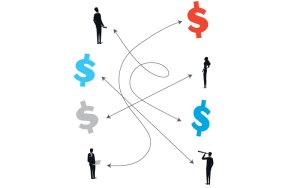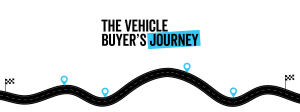Brochures can be beautiful. Whether you’re showcasing well-designed products, the newest car models, or mouthwatering food, the power of photography or artwork in your hands is palpable. The color is truer than on a screen and you don’t need to scroll to see everything. In fact, marketing research finds that physical media is more memorable, more persuasive, and more likely to drive behavior than digital media.
Brochures achieve a number of important marketing objectives: they showcase products, build brands, provide a longer format for more information, increase leads, maintain staying power, and have the ability to be passed along. They complement a digital strategy by driving traffic to your site. They are easy to create and distribute and highly cost-effective.
Related: Hitting your Brochure Design Out of the Park
BUT HOW MUCH DO BROCHURES COST?
Brochure pricing is surprisingly reasonable, with a strong ROI. However, several factors can affect price. These include:
It’s important to note that now more than ever, costs are constantly fluctuating due to supply chain issues. This is why it’s important to order your print marketing materials AHEAD of time to avoid running into low stock. Let’s look at typical costs and the best ways to maximize your budget.
CREATIVE & DESIGN COSTS
$0 – $3.00 Per Person
You’ll start here. If you don’t have an in-house writer and designer, we recommend hiring them. Professionals are trained in the nuances of effective marketing practices, and the work will reflect a high level of professionalism. Good copywriters and designers typically charge between $75-$125 per hour.
Expert Tip: A 12-page brochure requires a half-hour to an hour per page, which would cost approximately $900-$3,000.
PRINT PRODUCTION
$.03 – $2.00 Per Person
In print production, the main factor to worry about is paper stock. However, there are several details about paper stock to keep in mind when preparing an order.
PAPER STOCK
The feel of your brochure is critical, so choosing a high quality, thick and smooth paper will accentuate your graphics and lend credibility and heft to your message. Studies bear this out. Typically, printers offer a “house stock” that is cost-effective. Heavier weights will cost more.
Size – what is your finished and flat size of the brochure?
Press sheets determine the costs here. Smaller pieces cost less to produce since you can fit more on a sheet.
Quantity – how many brochures are you printing?
Higher volumes equal lower costs per piece. Although you’ll have a higher total, your ROI will be greater because your cost per lead is less. You can print more brochures now and mail them out over a period of time, spreading the cost of print and postage – or use them as sales tools or displays.
Ink – color or black and white?
Four-color costs more than two-color but there’s not an appreciable difference.
One-sided Versus Two-Sided – one or two sides of print?
Most marketers print two-sided to maximize the space; there is a slight cost increase, but it’s recommended to use both sides.
Printing Digital Versus Offset – does your project require a digital or offset press?
If a project requires 2,500 sheets or less, the recommendation would be to use the digital press; if it’s more than that – use offset equipment. One is not necessarily more cost-effective than the other; costs depend upon quantities, size, print versions and personalization if needed… You can work with Ironmark to find the best option for your project.
Folding – how many folds will your finished brochure have?
Some common brochure formats include trifold or bifold, and many can be made to accommodate coupons as well as additional pages or fliers. Most brochures need to be folded and sealed with a wafer seal (clear tab) or the unfortunately named “booger glue” so it stays closed in the mail. If you’re not distributing through the mail, this is not necessary.
Finishing Technique – how fancy do you want to get with your brochure?
To create a uniquely shaped piece, you can have a specially shaped die cut designed. Although these highly impactful pieces can be more expensive, the die cut can be used repeatedly in the future for no additional cost.
MAILING LISTS
$0 to $0.30 Per Record
If you have a customer list, this part is free. If you need to buy a list, the cost depends on how many records it has, how clean the data is, and how many times you’ll use that list.
Related: 8 Excel Hacks for a Squeaky Clean Mailing List
ENVELOPES, LABELS, POSTAGE AND FULFILLMENT
$0.25 – $2.00 Per Piece
Since a brochure is a self-mailer, you can usually skip the envelope. Postage is a good place to save money. We can also help you find ways to reduce costs, and the USPS offers a tool to calculate your business mailing price.
It’s important to look at the big picture to reduce postage costs. If you find that your prospects are concentrated in a specific area, it may be more cost-effective to send the brochures on a truck to that city’s USPS mailing hub, rather than mailing them from further away. Commingling is another strategy that helps reduce costs; your brochures are included with other mailers and then sorted at the carrier level so your post office has less to do.
BROCHURE COSTS: PUTTING IT ALL TOGETHER
So how much does it cost to print and ship brochures? As you’ve seen, there are a number of different scenarios, depending upon the various requirements for your piece. But if executed well, an investment in this highly effective marketing vehicle will pay for itself well beyond its cost. For the most accurate quote on professional brochures and other print projects, contact the experts at Ironmark today.




